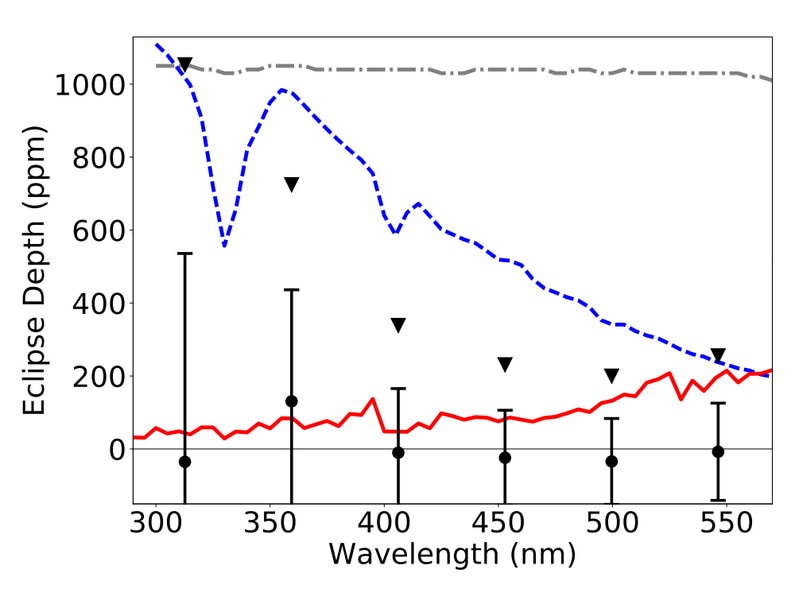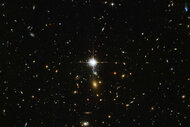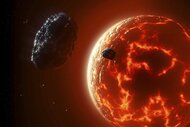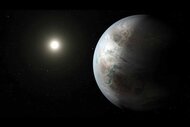Create a free profile to get unlimited access to exclusive videos, sweepstakes, and more!
Pitch black planet
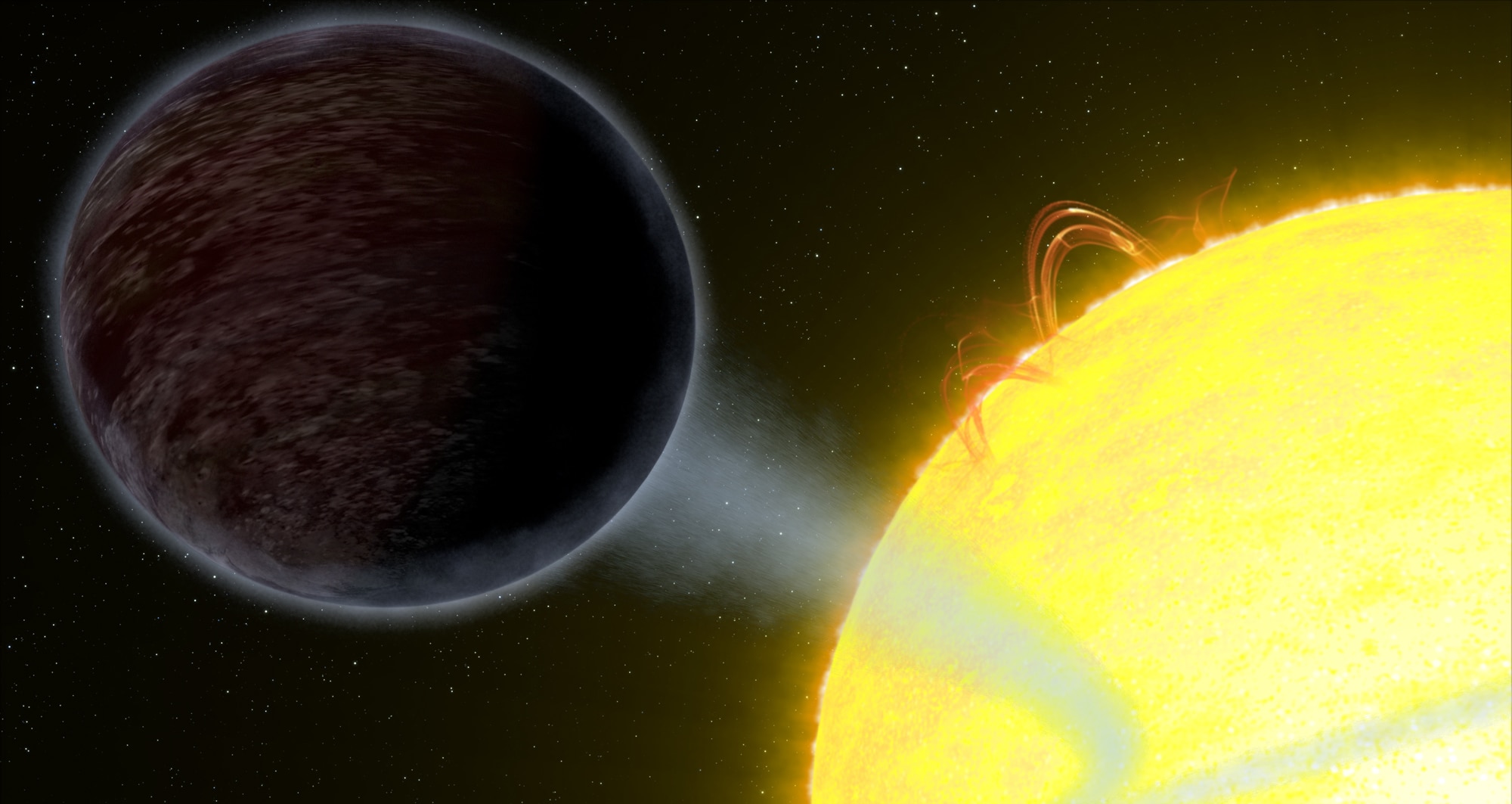
Over a thousand light-years from Earth, there is a decidedly odd planet. It orbits the star WASP-12 — named so because it was the 12th star found to have a planet by the Wide Angle Search for Planets consortium. The star is somewhat more massive and hotter than our own Sun, and the planet is called WASP-12b, as is the convention.
This is no planet like we have in our own solar system. The closest analogue would be Jupiter; WASP-12b is about 40% more massive. But a funny thing was discovered immediately upon its discovery: It’s much larger than Jupiter, almost twice its diameter. That is very peculiar. When planets get to be around the mass of Jupiter, an odd quirk of physics called degeneracy kicks in, which changes how the material inside the planet behaves under pressure. When you add mass to such a planet, it actually gets smaller, not larger.
So, why is WASP-12b more massive than Jupiter, and larger? Because it’s hot. Really hot. It orbits its star a mere 3 million kilometers above its surface, far closer even than Mercury orbits our Sun! Its proximity means the planet is broiled by the star, and may have a temperature of 2300° Celsius (almost 4200° F) at its cloud tops. That heat puffs up the outer atmosphere, making the planet larger than you’d expect for its mass.
And now astronomers have discovered something else that’s bizarre about the planet: It’s dark. Like really unusually so. Most planets reflect quite a bit of light that falls on them from their star; for example, Earth is about 40% reflective (in astronomer lingo this is what we’d call an albedo of 0.4). However, new observations of WASP-12b show it reflects a mere 6% of the light that hits it (an albedo of 0.06), roughly the same albedo as asphalt. And that’s an upper limit! It might even be darker.
This was discovered in a clever set of observations using the Space Telescope Imaging Spectrograph (STIS) — a camera on board the Hubble Space Telescope that can break light up into separate colors and analyze it. In a sense, it spreads the light out like a rainbow, but a rainbow with hundreds or thousands of colors. By examining the resulting spectrum, we can learn a lot about the object giving off that light.
WASP-12b lends itself well to this type of camera. That’s because, due to a favorable geometry, we see it orbiting its star edge-on from Earth. That means, once every orbit, it passes directly in front of its star, blocking a fraction of the light. But that also means that, half an orbit later, it passes directly behind its star. Most of the time during its orbit, we see the light from the planet and the star together, but, for that short time while it’s eclipsed, we see only the light from the star.
The star is bright enough that seeing the dip in light when the planet blocks it isn’t too hard. But the planet is faint — literally a billion or so times fainter — so seeing the light from the system drop when the planet is in eclipse is extremely difficult. However, STIS is quite an amazing machine, and is capable of making this observation*.
The observations were made right before, during, and after an eclipse. Right as the planet slips behind the star, the light should drop, and then it should come back up when the eclipse is over. And what they found was ... nothing. As in, the amount of light they saw in every color was fairly steady, when it should have dropped a bit. The only explanation is that the planet is absorbing nearly all the star’s light that falls on it, reflecting almost none. It’s dark.
That’s interesting right away. A couple of previous observations made of the planet indicated that it might not have any clouds in it (not water clouds as on Earth — at those temperatures, water gets ripped apart into its individual hydrogen and oxygen atoms — but some other material that can condense in the upper atmosphere), or it might have an atmosphere of aluminum oxide haze. However, either of these two cases would show a change not only in brightness during the eclipse, but also in color (for example, clouds in the planet’s atmosphere would reflect more blue light, so the spectrum would show a bigger drop in blue light than red if the clouds were there). Yet neither of those two models fits the STIS spectra. Instead, it’s more likely WASP-12b has an atmosphere of hydrogen and helium. Those gases absorb all the light coming from the star, which is why it’s so dark.
Another interesting thing: The planet orbits so close to its star that it should be tidally locked to it; that is, spin once for every time it orbits (this happens naturally over time when any object closely orbits another, like our own Moon). That means one side always faces the star, and the other faces away. When it’s about to be eclipsed, we only see the day side of the planet (it’s on the other side of the star from us, so we see it fully illuminated), where it’s very hot. But temperatures on the night side may be much lower, by as much as 1000°C. That means different chemistry can occur there, and there may yet be water vapor and other materials that can condense to form clouds. We just don’t see them in this observation because they’re on the other side of the planet.
What an odd place.
And there’s yet one more thing. The press release for this news says the planet is “pitch black,” which is fair enough. But by that they mean the planet is dark, non-reflective. This doesn’t refer to the actual color of the planet, just the brightness! My friend Kiki Sanford (who runs the wonderful This Week in Science podcast) asked me about this, and makes a good point: At 2300° C, the planet should actually glow under its own heat.
She’s right. Anything above a temperature of absolute zero emits light, and the warmer it is, the higher energy the light is. At WASP-12b’s temperature, it should peak in the infrared, just outside what our eyes can see. But that’s just where it would emit the most light; it still should emit some light in visible colors. It does, but not much. The STIS spectra are consistent with it being very slightly red, which is what I’d expect for such an object, but they’re not conclusive.
Still, that’s a funny thing to think about: It’s emitting its own light, faintly, but at the same time it’s so absorbent it reflects almost none from the star. If it had a reflectivity like Earth it would look far brighter due to reflected starlight than from its own internal heat.
So, if you were floating next to it, would you see it? Almost certainly yes. Unless it reflects absolutely no light at all, it’s so close to the star that a lot of light is falling on it, so even if the albedo is, say, 0.01 (and it’s hard to see how anything could be that dark), it would still reflect enough light to see.
So, “pitch black” is an accurate term, but a little misleading. It’s not black per se. It’s reddish, but it’s dark.
Hmmm. “Dark planet” is actually a rather more foreboding term, isn’t it? I like it better. It’s cooler (though not literally).
And it’s weird. The only other exoplanet we’ve been able to observe via reflected light is HD189733b (which, like WASP-12b, is a hot near-Jupiter-mass planet), but it’s far cooler and tends to reflect light better in the blue. This means its atmosphere must be very different from WASP-12b’s.
We’ve observed two planets like these in this way, and they’re very different. That’s exciting: It means that “hot Jupiters” are diverse, and that, in turn, means that every one we observe will tell us something important. Studying exoplanets in this way is a very new science; we’ve only just started here. I can’t wait to see what else we’ll discover!
* If I sound like I’m bragging, why, yes, I am: I was on the team that built STIS and I helped calibrate before and after launch. Despite that, it works very well.
UPDATE (Sep. 26, 2017 at 18:30 UTC): Exoplanet astronomer Dave Kipping alerted me that as it happens, a darker exoplanet is known: TrES-2b. And he should know: He's the lead author on the paper about it!
